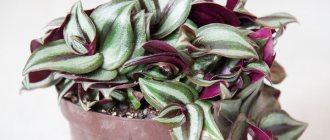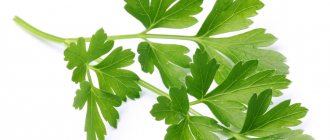If the plant requires replanting, then this action must be performed with extreme care, trying not to damage the root system. As soon as the orchid is removed from the pot, the roots are washed with warm, running water and inspected. All damaged areas are removed with sharp, disinfected pruners and treated with ash or ground cinnamon. After this it is left to dry. After 5-7 hours, the plant can be placed in a special substrate.
How to determine pathology?
Often, the roots of orchids that grow at home undergo pathological changes. They not only change color, but also their appearance - they darken and begin to rot.
There are 2 ways to distinguish healthy roots from damaged ones:
- Color . A healthy orchid horse system is covered with a protective, spongy substance called velamen, which has a bright white tint. The roots can also be green or silver. If the color has changed, then this is the first sign that the plant is starting to hurt.
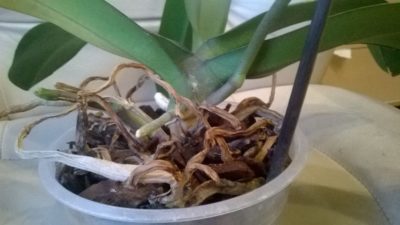
If the plant does not get enough sunlight, the roots may change their color to yellow - but they remain healthy.
- To the touch . It is enough to squeeze the root slightly - it is elastic, then everything is in order. But if mucus is released from the root and it is easily crushed, then it is rotten.
Do not rush to trim the roots if they are of normal color, but wrinkled and thin. Dip the orchid roots in warm water for an hour, they will be saturated with moisture and become normal.
What causes damage?
When replanting a plant, you need to be very careful , since damage to the roots can lead to negative consequences: rotting at the site of damage, and a third-party infection can also get into the wound.
Drying of air appendages
Identifying the cause
The appearance of roots in the aerial parts of orchids is a natural process , since they are part of the nutrition system. Their condition determines the development of the epiphyte: health, energy, strength, frequency and duration of flowering.
Damage or deterioration of the air appendages threatens to dry them out, which can lead to the complete death of the exotic pet. The manifestation of problems in the above-ground food system requires immediate action.
Healthy aerial roots can be distinguished by the following characteristics:
- quite dense to the touch;
- fleshy texture;
- the surface is smooth;
- tight when pressed;
- have a silver-green or shades thereof color.
Wrinkling, oiliness, loss of density, dark spots or dark color require immediate action from the owner.
What to do?
If the aerial roots are dry, first of all it is necessary to find out the cause of this condition and try to eliminate it immediately. If the situation has not gone too deep, then you can get by with a single pruning of the damaged roots. If the condition is sufficiently neglected, a transplant should be carried out urgently, following the instructions of experienced orchid growers.
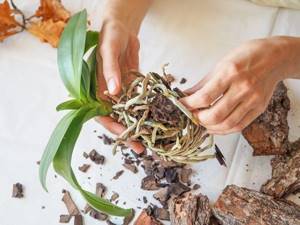
If the roots are severely damaged, the orchid should be urgently replanted.
What can be processed?
Drugs used
Orchids are susceptible to many types of infections and diseases. To prevent the plant from getting sick, you can use the following formulations once a month:
- "Fitosporin" - helps in the treatment of orchids from viral diseases and as a prophylactic when replanting a plant with damage to the roots.
- " Chlorhexidine" - destroys all diseases caused by pathogenic bacteria.
- “Fundazol” is a universal remedy; before planting the orchid in a new substrate, you can simply dust it with powder.
- "Oxychom" - fights all rot and other diseases of orchids.
- “Fito Plus” - this drug copes well with powdery mildew and rot.
- “Topaz” - saves from rust and powdery mildew.
- “Streptomycin sulfate” - helps well with bacterial infections, with 1 ampoule diluted per liter of water.
- “Immunocytophyte” is an immunomodulator for orchids that can suppress many diseases.
Powders and drying
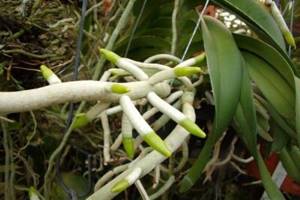
After pruning, all wounds must be treated to prevent diseases, infections and decay. Apply:
After treatment, the plant is left in the air for 5-7 hours to dry the roots, and only then placed in a new substrate.
Reasons for replanting an orchid
A beautiful orchid can only grow in good soil, saturated with microelements. Unfortunately, over time, the substrate becomes depleted and the plant needs to be replanted. There may be several reasons for the loss of beneficial properties:
- Low breathability. Since the orchid is an epiphytic plant, and its root system wraps around tree branches during its growth, the soil is usually made from the bark of coniferous trees. This ensures normal air circulation in the pot. However, over time, the bark swells, the substrate becomes compacted, and the soil loses its breathability.
- High acidity. In order for an orchid to develop properly, its soil must be saturated with useful substances, while maintaining an acidity level of 5.5 - 6.5 pH. When these indicators increase, the root system will stop receiving iron, as a result of which the foliage will turn yellow and fall. The process of increasing acidity is inevitable, so it makes sense to replant the orchid in a new substrate.
- Accumulation of salts. Ordinary water for watering orchids contains iron, high pH, heavy metals and other components that adversely affect the development of the plant. In this case, the root system ceases to perform its functions, rotting or drying out.
There are times when an emergency orchid transplant should be performed. The main factors indicating the need for an urgent procedure include the following:
- decomposed substrate;
- root rotting;
- the presence of pests in the pot (slugs, mites, snails, worms, etc.);
- growth of the root system beyond the size of the container;
- The orchid is “dangling” in the pot.
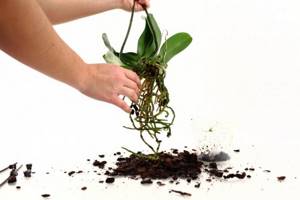
Orchid transplantation is a mandatory measure to extend the life of this delicate flower.
Step-by-step instruction
What if there is no root system?
So, the plant has partially or completely lost its roots as a result of rotting. You can save the plant by acting step by step with the following steps :
- Carefully remove the orchid from the flowerpot.
- Rinse what remains of the root system in warm running water.
- Dry in warm open air and inspect. If healthy roots remain, they should not be removed - the chances of survival will be greater.
- Remove all damaged tissue with a sterile instrument, dry the cut a little and treat with ash or charcoal.
All further actions will directly depend on the type of orchid and the extent of the damage. If there is no root system left at all, then you need to try to grow them:
- Build a small mini-greenhouse.
- Fill it with a mixture of expanded clay and sphagnum moss.
- Treat the orchid with a special preparation – “Epin”.
- Place the plant in the structure and place it in diffused light.
Reasons for appearance
An orchid is a striking representative of tropical plants that has an unusual root system. It belongs to the family of epiphytic plants and has not only ordinary roots, but also aerial ones. This plant was introduced to European countries from regions with a tropical climate. Initially, aerial roots helped the plant to attach to tree trunks, rocks and huge stones, and also made it possible to obtain water and all nutrients from moist air. The main feature of an orchid is the use of large plants only as a support for growth, and not as a source of nutrients.
The unique structure of thick and cylindrical aerial roots, the surface of which has a porous and spongy structure , allows the flower to accumulate moisture and minerals and, if necessary, use it for growth and development. To reduce the level of mechanical damage, the plant has a special protective layer of brown color - velamen. In the dry climate of an ordinary apartment, the plant produces a lot of aerial roots, which appear throughout the entire period of life and provide additional moisture. Plants in pots send aerial roots into the soil.
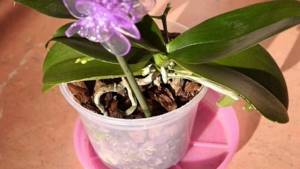
How to reduce the appearance of aerial roots
Beginning gardeners are advised to choose a modern plastic pot with transparent walls for growing orchids. Then it will be possible to control the condition of the root system. To ensure a normal level of ventilation and watering of the plant in the container, you need to make drainage holes up to 1 cm in size.
In addition, to reduce the likelihood of aerial roots forming, it is necessary to monitor the conditions under which the tropical guest is kept, especially in winter. Since running heating radiators dry out the air, it is better to remove orchids from window sills deeper into the apartment. Otherwise, the plant becomes uncomfortable, and in search of a source of moisture, it begins to grow tentacles that stretch in different directions.
Why does an orchid need aerial roots?
Epiphytic orchids, growing on trees in the middle and upper tiers of the jungle, do not touch the soil. They get nutrients in a different way. In tropical forest conditions, fallen leaves, bird droppings, and dead insects constantly accumulate in the axils of tree bark and in rock cracks. All this biomaterial decomposes and saturates the water with organic compounds. The aerial roots of orchids absorb not only distilled rainwater, but also a “broth” in which nutrients are dissolved. Due to them, the orchid grows and builds its body.
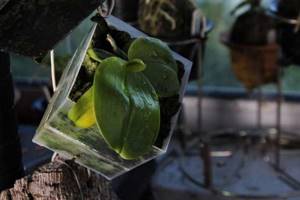
The difference between living roots and dead ones
Healthy roots are elastic to the touch, they are white and greenish inside. This is the main sign that the root shoots are alive. Dead roots are not flexible, they are brittle and brittle. Dead roots may feel empty to the touch; when you press on them, a crunching sound is heard.
If the root system dies from fungi that cause rotting, an unpleasant odor emanates from the planting pot. Dead roots have a black or brown color. They have areas saturated with mucus.
How are they different from ordinary ones?
An orchid is a unique plant that does not grow in the ground under natural conditions. Aerial shoots do not have a central root system and grow along the main stem, sometimes above the lower leaves. The root system of a plant grown under artificial conditions, some of whose aerial roots are placed in the ground, has thicker and more powerful above-ground shoots than underground ones. More pressing questions for novice gardeners remain finding the differences between peduncles and above-ground roots due to the formation of the same gap at the base of the leaf upon emergence.
Their main functions
The main function of aerial roots is to provide the plant with essential nutrients. The aerial root system of an orchid is of great functional importance in its growth and full development, and also contributes to the formation of new shoots. Under natural conditions, the plant is forced to adapt to life on the branches of large trees and rocks, on which these shoots help to gain a foothold. Due to the impossibility of obtaining moisture and nutrients from the soil, the orchid is forced to use air outlets that absorb and accumulate moisture particles from the air and are adapted to absorb sunlight. Aerial shoots act as an indicator of the health and age of the plant.
To determine the age of an orchid, you need to pay attention to the color scheme of its roots:
- young plant – bright green palette;
- old flower is a pale and muted shade.
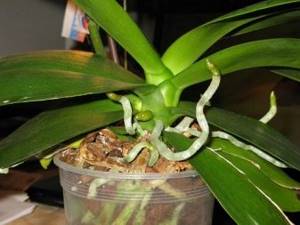
Important! The lack of formation of young roots over a long period of time is a sign of improper care, decreased immunity and the possible development of various diseases.
Aerial roots
Structure
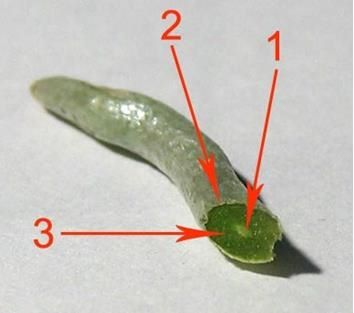
Rice. 1 - structure of the aerial root.
to disassemble the structure of the above-ground root from its most important integumentary part, suberized, consisting of dead hygroscopic tissue - velamen:
- Central cylinder;
- Velamen;
- Cortical parenchyma.
Velamen is a coating consisting of dead cells, with properties reminiscent of a sponge. It has good absorbent properties and at the same time releases moisture. This layer is formed only during the period of active growth.
Under natural conditions, in epiphytic orchids this layer is quite thick, since its formation is carried out and depends on tropical natural periods of rain and drought. The thickness of the coating depends on the speed of drying after rain. The faster it dries, the better the layer grows.
At their core, all orchid roots are aerial . In nature, they grow over fairly large distances and wrap around tree trunks or other natural objects for stability and to obtain the necessary life-support substances. At the same time, they are not parasites.
The substrate, when grown at home, serves them for a stable position and as a means of providing nutrition and moisture to the grower.
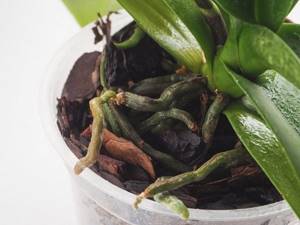
At home, the substrate only serves as a support for the roots.
Meaning for the plant in nature
Aerial or respiratory roots are characteristic of plants growing in tropical zones with oxygen-depleted soil. Such lateral roots, growing above the ground, absorb oxygen and water from the air in conditions of high humidity.
In addition to receiving nutrition and moisture from the air, most orchids attach themselves to trees, which serve as support for them. Having caught on a trunk or ledge in a rock, the epiphyte uses them as support and nutrition , but does not feed on the plant sap. It collects nutrients from the surface (fallen leaves, bird droppings, dead insects, parts of dead bark). These rotted remains provide it with a substrate that promotes the development of the plant.
Functions
If the root system of the main group of plants receives nutrients, mineral salts and moisture, penetrating deep into the soil and absorbing what is necessary with the help of root hairs, then this method of extraction is not acceptable for the majority of orchids.
Growing in tropical forests, such soil simply does not exist.
In orchids, the root system consists of a large group of adventitious roots that perform two main functions:
- Absorb nutrients and moisture from the environment and facilitate their transport to leaves, stems, flowers;
- Securely anchor the plant to the soil or support . This is especially important for epiphytic orchids, since growing in tropical conditions, they are often exposed to winds and rainfall.
In different types of orchids
Epiphytic orchids form aerial roots covered with a thick layer of hygroscopic tissue consisting of dead cells and filled with air. The main function of such fabric is the ability to absorb rainwater, morning dew and moisture from the atmospheric air. Epiphytes are plants that live on other plants, but do not take nutrients from them.
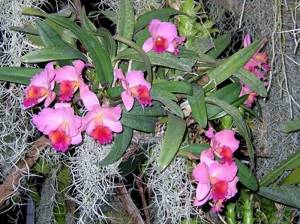
Orchids in natural conditions.
There is also a small group of aerial root orchids that naturally prefer to live on rock ledges, stones or boulders. These are lithophytic orchids. In addition to feeding from the atmosphere, they absorb nutrients from mosses, their own dead tissues, or from the structure of rocks (carbonate, calcareous, dolomite, marble).
Some species may have both epiphytic and lithophytic functions.
The most common species in home floriculture that have aerial roots are:
- Brassia;
- Cumbria;
- Cattleya;
- Cymbidium;
- Dendrobium;
- Lycasta;
- Miltonia;
- Odontoglossum;
- Oncidium;
- Paphiopedilum;
- Phalaenopsis;
- Zygopetalum;
- Wanda;
- Rhynhostilis;
- Aganisia;
- Ludisia;
- Kaleana;
- Celogina;
- Grammatophyllum;
- Neophinetia;
- Sedirea;
- Miltoniopsis.
Reasons for appearance at home and their norm in the plant
If in natural conditions orchids the roots serve as a source of nutrition, moisture and as a support, then at home, being in a container with a substrate, some of the soil is transformed into air . There are several reasons for their appearance on top of the ground. This is neither good nor bad, but when their number exceeds 4-5, it should cause concern for the owner.
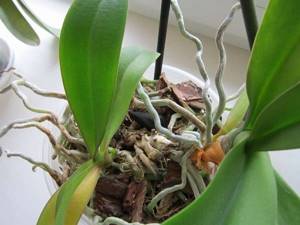
An excessive number of aerial roots should alert the owner.
- Substrate . Incorrectly selected components or a small fraction of the substrate does not allow the roots to fully develop. Compaction and salinity of the soil also causes the formation of above-ground roots to obtain nutrition, moisture from the air and ensure the operation of photosynthesis;
- Problems with underground roots . Overwatering, drying out, diseases and pests lead to damage, drying out or rotting of the root part. Stopping work stimulates the release of aerial roots;
- Nutrition. Lack of nutrients in the substrate;
- Temperature . An increase in temperature inside the container caused by direct sunlight or heating devices.
The normal number of aerial roots can be from 2 to 5. Excess, although not a serious problem, should cause some concern, since the cause may be quite serious.
Is overgrowth a pathology or not?
There is no pathology in the growth of aerial roots in a healthy and developing plant. The appearance of ground branches serves as a good support and part of the additional nutrition of the tropical beauty.
What to do with them when transplanting?
Like any other plant that is kept at home, an orchid needs timely care and replanting. When changing nutrient soil and pot, experienced gardeners do not recommend covering the roots with soil and burying them in a flower container. The aerial shoots should be left completely open on the soil surface or covered with a small amount of moss , which will enable them to retain moisture for a long period of time. If it is necessary to obtain a new plant, experts recommend propagating it simultaneously with replanting. For planting, you need to choose healthy roots that have several pseudobulbs.
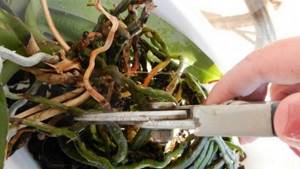
The planting material is cut off with a sharp knife, and the cut area is sprinkled with activated carbon powder.
Do they need to be trimmed?
The orchid is an unusual plant that has a non-standard root system. Many novice gardeners, trying to give the flower a classic appearance, cut off the aerial shoots. This manipulation is not only impractical, but can also damage a healthy flower. Experienced gardeners recommend removing roots only in exceptional cases if there are visible reasons.
The following reasons for pruning air shoots are possible:
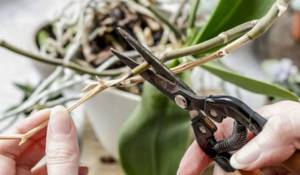
It is worth paying attention to the following signs of roots that need to be removed:
- discoloration of shoots that turn brown, yellow or black;
- the presence of an oily surface;
- the appearance of cracks;
- a significant reduction in their volume;
- the appearance of wrinkles.
Healthy roots, which are strictly prohibited from being removed, have the following features:
- dense and fleshy structure;
- smooth and even surface;
- bright colors;
- absence of mechanical damage and signs of fungal diseases.
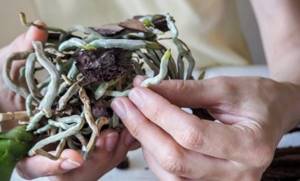
Important! If there is a powerful, long and healthy root system of a soft green color with a silver tint, it is strictly forbidden to remove it or injure it.
Subtleties of care
To get a healthy plant with a moderate number of aerial shoots, you need to carefully study all the intricacies of caring for it. You should adhere to the following rules for caring for an orchid:
- placing the plant on a vertical support without a container with soil;
- transplanting the plant into a transparent pot if it is not possible to grow it in a suspended state;
- use of additional lighting devices;
- protection from direct sunlight;
- creating a comfortable temperature regime, which ranges from +16 to +30 degrees;
- daily watering in summer and 3 times a week in winter;
- regular application of organic and mineral fertilizers;
- carrying out spring plant transplantation.
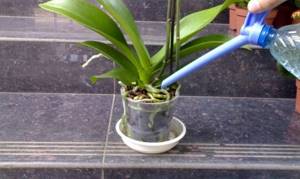
Plant replanting should be carried out according to the following recommendations:
- removing a flower from an old pot;
- removing old soil from the surface of the root system under running water at room temperature;
- removal of damaged and dry parts of the plant;
- disinfection of cut sites;
- laying drainage materials at the bottom of the new flower container;
- placing the plant in a pot and carefully filling the container with nutrient soil without compacting it.
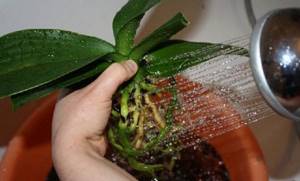
When a large number of above-ground shoots are formed, botanists identify the following types of reasons:
- high level of temperature in the room;
- low percentage of air humidity;
- excessive soil moisture;
- poor room lighting;
- increased soil density.
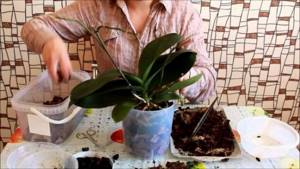
If there is no underground root system, experienced gardeners recommend building it up. To carry out this procedure, you need to place the flower in a container of water, to which a root formation accelerator, phytosporin, a little honey and sugar, as well as a B complex of vitamins have been added. A prerequisite before growing roots is to remove damaged areas of the plant and disinfect the cut sites. The optimal air temperature in the room is +28 degrees. To fill the cells on the surface of the leaves with water, you need to regularly wipe them with an aqueous solution of succinic acid, because it is an indispensable assistant in strengthening the immune system and in the formation of a strong root system.
Watering a tropical plant can be done in the following ways:
- shower - washing the entire plant with room water using a shower; after the procedure, the aerial roots should have a rich green color;
- immersion - completely lowering the pot into a container of water for a short period of time;
- regular watering - moistening the soil by watering it using a special garden watering can;
- Spraying is the best way to moisten the plant.
What to do with the roots
Some gardeners unknowingly bring their orchids to a deplorable state. But this flower has a huge thirst for life, and you need to fight for it to the end. Is it possible to save an orchid if the care was absolutely incorrect and even destructive? As a rule, there is always hope for salvation. Even if the roots have rotted from excessive watering and only a couple of aerial roots remain, you can try to save the plant.
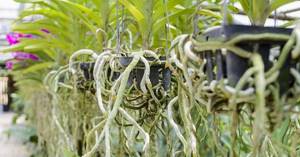
It will not be possible to save the only orchid whose center of growth—the crown of the plant’s rosette—is rotting. This can occur as a result of stagnation of water between the leaves at the growth point, as a result of which putrefactive processes begin. It is enough to be careful that no water gets into the outlet during watering, and if it does, simply drain it.
The sequence of actions is as follows.
- You need to remove the bush from the flower pot, wash the root system, and remove rotten roots.
- At the base of the rosette there are dry scales from previously dried and fallen leaves.
- New root shoots are born under these scales - you need to make way for them.
- Carefully remove dry scales with your hands; do not use knives or scissors, so as not to injure the plant and accidentally cut off young shoots.
- The plant is ready to be planted in a new pot.
Do I need to prune aerial roots and when?
Roots that have come out of the pot spoil the appearance of the flower, but they should be perceived as a physiological feature of the plant. Root shoots reach 10-70 cm in length. There is no need to trim a living and healthy root system.
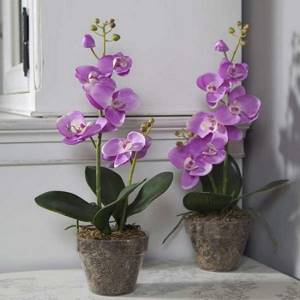
Pruning is carried out if:
- Brown, black, rusty spots of rot appeared on the living root and in the velamin.
- The roots became soft and slippery when pressed.
- The roots have dried up.
Step-by-step instructions for trimming dry roots
Proper pruning of roots and resuscitation of the plant after it should be done as follows:
- Carefully remove the plant from the substrate. Pieces of turf that are pressed inside the roots will have to be removed by hand, straightening and unraveling the coils at the same time.
- Shake out small parts of the soil, then place the entire plant for 5 minutes in warm water with phytosporin or a weak solution of potassium permanganate.
- Remove the plant and air dry the rhizomes. Blot the inside of the leaf rosettes with cotton pads or paper napkins.
- Disassemble tangled roots and remove dry or damaged parts. After this, you should carefully examine the roots and make sure that only healthy areas remain.
- Sprinkle the cut areas with coal or ash.
- Place the epiphyte in fresh substrate.
- Place the pot in a container of clean water and cover with a plastic bag. Leave the last one for a day.
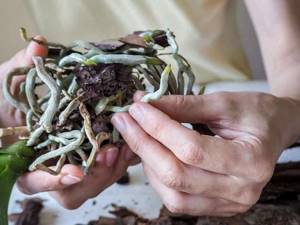
Greenhouse conditions will help the plant recover faster. Evidence that the pruning was carried out on time will be young shoots that will appear within a week.
Possible problems
Many orchid owners may observe the appearance of dry and lifeless roots that dry out, die and break. If this problem occurs, experts recommend finding the reasons for its occurrence. Only a competent and comprehensive approach to solving this problem will help save your favorite plant. This plant may have several of the most common problems.
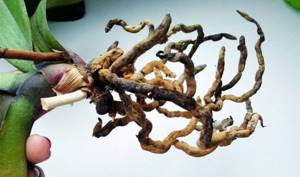
Drying of aboveground shoots
This is the appearance of dry shoots. The reasons include the following factors:
- lack of moisture - low air humidity and abundant moisture in the nutrient soil;
- mechanical damage - injuries that the plant may receive during transportation or transplantation, especially the delicate buds of the plant;
- burn - damage to the root system caused by improper use of chemical fertilizers or watering water with a high chlorine content.
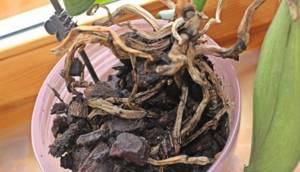
Fungal diseases
At the first signs of the appearance of dry shoots, it is imperative to remove them and treat the cut sites with antiseptic drugs.
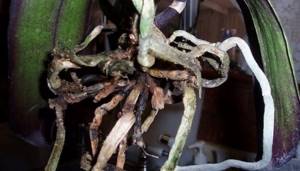
Rotting
Rotting is the appearance of dark shoots that have a loose and moist structure. The causes of the disease include the following:
- high level of soil density;
- presence of dangerous pests;
- abundant watering;
- applying large amounts of concentrated fertilizers;
- mechanical damage;
- late blight;
- brown rot.
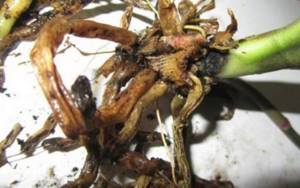
To preserve the plant, you need to transplant it into new soil with preliminary removal of rotten shoots and treatment of the roots with antiseptic agents.
Drying of underground roots
The causes of this disease may be the following:
- effect of low temperatures;
- lack of watering;
- overheating of the plant;
- salting of the soil and the occurrence of burns;
- fungal infection;
- presence of dry rot.
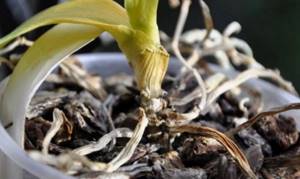
Mold plaque
This disease can occur due to the following reasons:
- abundant watering;
- low ambient temperature;
- low light level.
Indoor plants are not only part of the overall interior of the room, but also helpers that improve the mood and atmosphere in the family and purify the air.
To create favorable conditions for the growth and development of plants, it is necessary to carefully study their characteristics, as well as know the rules for caring for them.
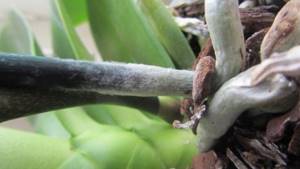
For information on what needs to be done with the aerial roots of an orchid, pruning or burying, see the video below.
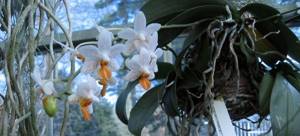
When a flower doesn’t look the same as in the picture, the owner gets worried and is at a loss. The question that worries gardeners most is: the aerial roots of an orchid - what to do with them if they appear and grow.
They look like predatory tentacles. But in order to get rid of them, it is necessary to find out the reason for their appearance. You need to know that orchid aerial roots are not a disease. They are part of the flower. They owe their appearance to their habitat and care. In nature, roots wrap around tree trunks and branches and receive nutrients from them.
Reasons for the appearance of roots
You shouldn’t count your roots every day and be horrified by the appearance of something new. Their quantity does not make the flower feel bad. But attention should be paid to the care and maintenance of the orchid. There are the following reasons for the appearance of roots:
- The problem may lie in the fact that a window sill is allocated for the orchid, which is located next to a heating radiator, which is extremely unpleasant for the flower. The solution would be to move the pot deeper into the apartment and place a phytolamp nearby.
- If the orchid has a lot of aerial roots, this indicates excessive watering. It is enough to reduce the amount of water, and the exotic plant will stop “releasing” its tentacles. If 2-3 roots remain, then this is normal.
Choosing the right filler for planting
This is the real cause for concern. You need to act immediately before the plant is completely destroyed. To do this, the rosette of the plant along with the roots must be removed from the pot, the roots must be thoroughly washed, disinfected, blotted from excess moisture and carefully removed the rotten shoots of the roots. After all the procedures performed, the plant must be planted in a new transparent flower pot filled with fresh bark prepared for planting orchids.
Another common reason for the appearance of aerial roots is the wrong mixture for planting orchids. Phalaenopsis should be planted in specially prepared bark and moss; under no circumstances should an earthen substrate be used. Soil is a very dense substance for phalaenopsis roots, so they do not grow into the ground, but shoot up. Those who had experience of planting orchids in an earthen substrate could see from their own experience that the roots of the orchid rot in the ground.
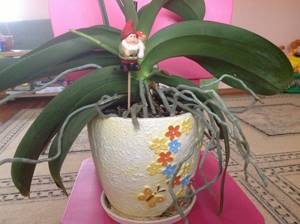
Immediately after transplantation, phalaenopsis can be watered for some time only with purified water without adding fertilizers, so as not to burn the weakened roots with the mineral solution.
Orchid transplantation - where to put the roots?
One of the features of an orchid is its replanting. The process proceeds differently than in other plants. The first thing they think about when replanting an orchid is where to put the aerial roots? After a new pot has been selected, the mixture has been prepared, and the root system has been washed, a little substrate is added to the bottom of the container. Then the aerial roots are straightened from above as much as possible. The space between them and the walls is filled with soil mixture.
When replanting, doubts arise: is it necessary to bury the aerial roots of the orchid? You shouldn't do this. Over time they will find a suitable position.
Many people wonder whether it is necessary to cut off the aerial roots of an orchid. The reason is the somewhat unaesthetic appearance of the flower. But no matter how many aerial roots there are, they cannot be touched. In particular, it cannot be cut off, because through the roots the flower receives nutrients from the air.






